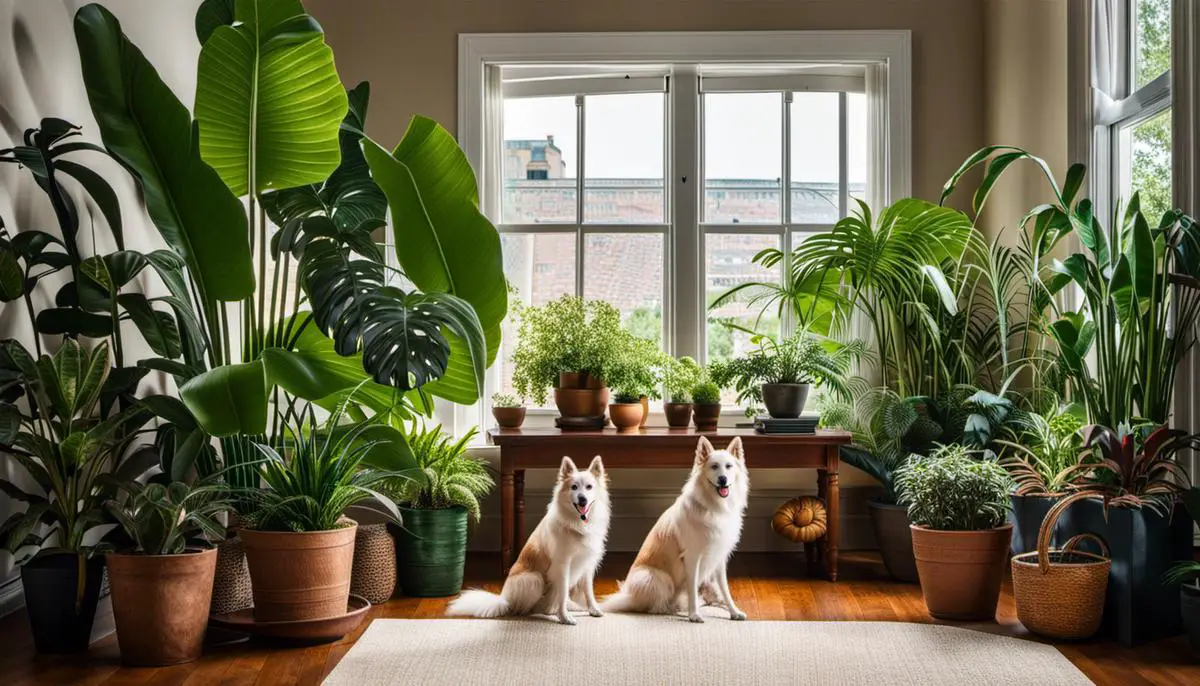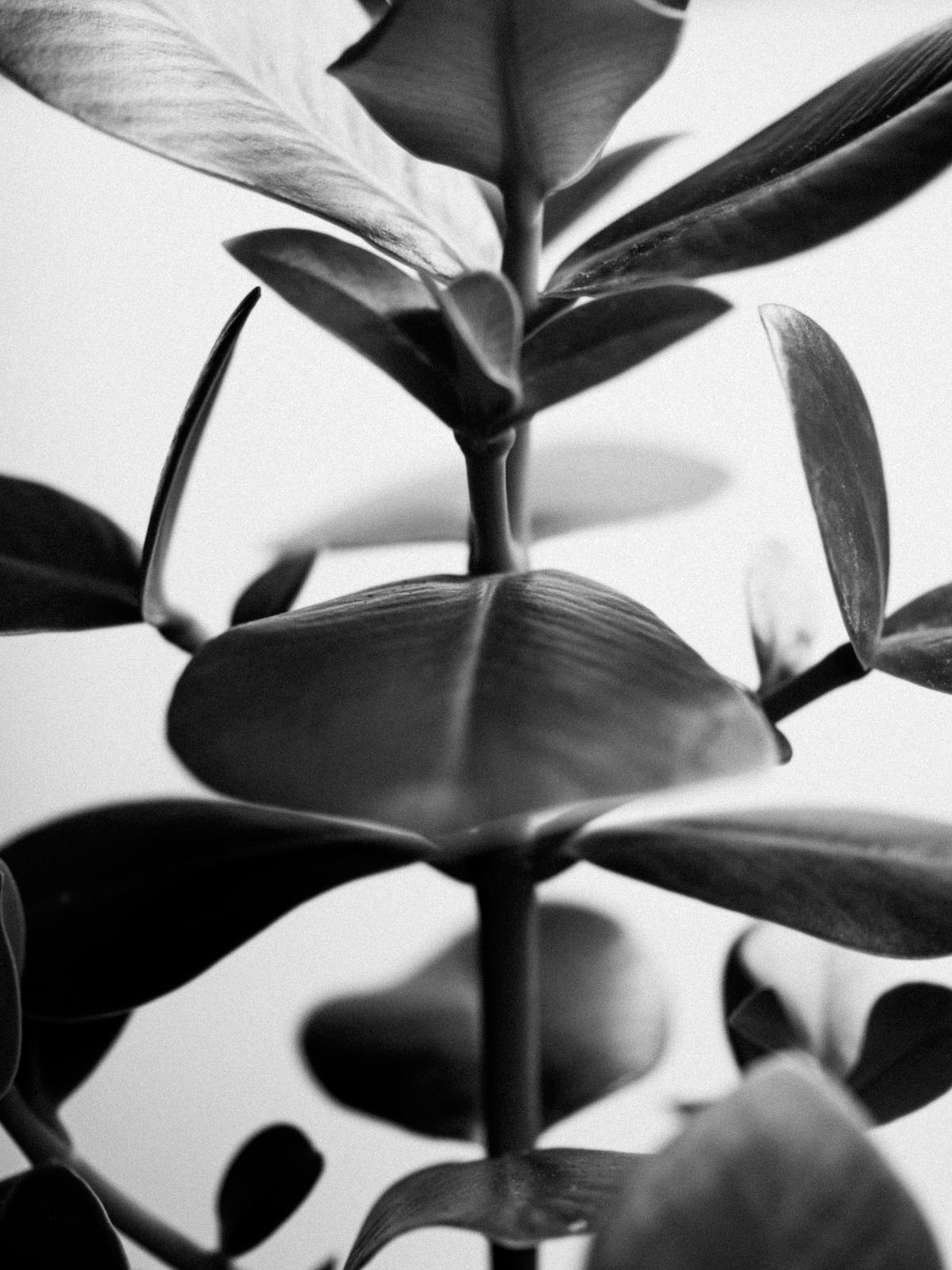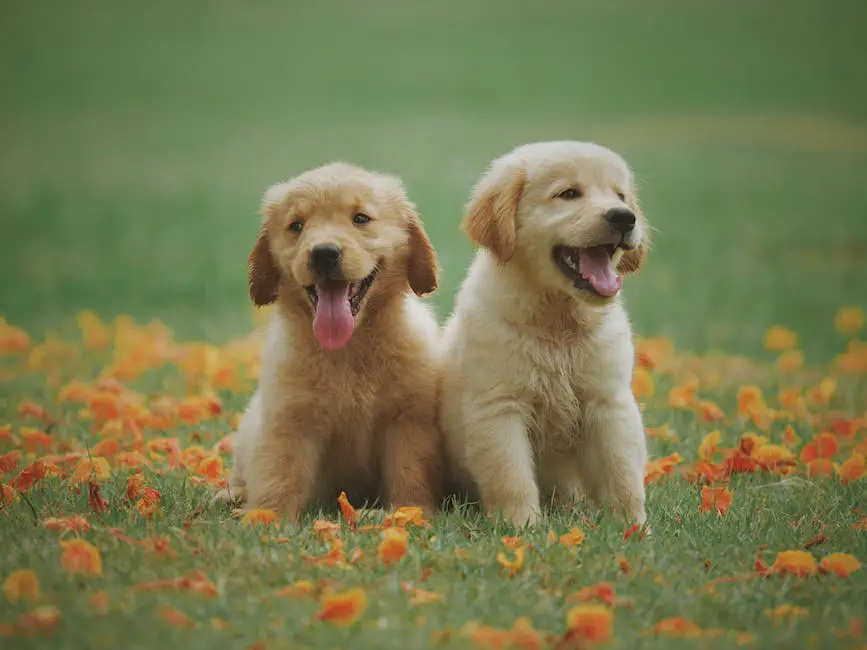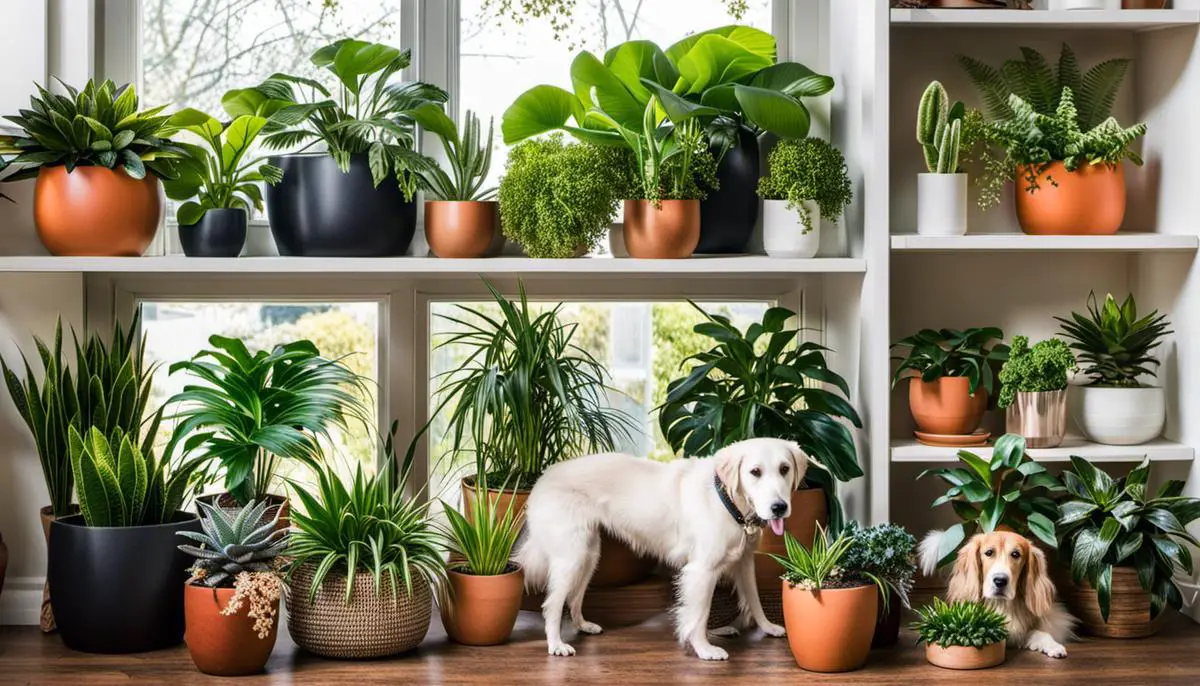For every household dog lover, creating an environment that is safe and invigorating for their four-legged friend is paramount. One of these involves thoughtful consideration of the houseplants you choose to spruce up your space. Cultivating your indoor paradise with plants does not have to come at the cost of your pet’s wellbeing. Whilst a lush indoor garden can beautify your home and improve air quality, certain plants can be toxic to dogs. This article aims to provide useful guidelines on dog-friendly houseplants, highlight perilous plants that dog owners should avoid, express key signs of plant poisoning in dogs, and offer practical tips for creating a dog-friendly indoor garden.
Dog-friendly houseplants
Dog-friendly Houseplants
As a dog owner, your plant selection process goes beyond just choosing the plants that require less maintenance or have captivating beauty. It’s crucial to also consider the potential risks they might pose to your furry companions. Some plants can be harmful and even deadly to dogs, therefore here is a look into the range of houseplants that are both attractive and safe for dogs.
Areca Palm
Areca Palm, often called a butterfly palm, is a popular plant for indoor spaces due to its ability to purify air. It features feathery, arching fronds that emanate elegance and grace. Its svelte stature is ideal for bright, indirect sunlight conditions. As for the thirst level, keep the soil evenly moist, but be careful not to overwater. A pet-safe plant, it provides a luxurious, tropical touch without worrying about your pet’s wellbeing.
Boston Fern
The Boston Fern is a classic houseplant choice known for its lush, feathery leaves. It is a perfect addition to a bathroom or kitchen, thanks to its affection for humidity. Keep the soil damp and place the fern in a room with indirect light. Not only does the Boston Fern improve humidity levels, but it’s also harmless for dogs.
Spider Plant
Spider Plants are undeniably a go-to houseplant for many plant owners. They are hardy, easy to care for, and tolerant of a wide range of light conditions but prefer bright, indirect light. They are known for their arching leaves that grow in a rosette form, and as their name suggests, produce spider-like plantlets. Spider plants are not only attractive and easy to grow but also completely safe for dogs.
Bromeliads
Bromeliads are tropical plants with vibrant flowers and foliage that can add a splash of colour to any indoor space. They require minimal upkeep, making them perfect for those who wish to beautify their homes without dedicating too much time to plant care. A bromeliad prefers medium to bright light conditions, with frequent watering and good drainage. Not only are they a sight to behold, but they are also safe for your dog to be around.
Swedish Ivy
Swedish Ivy is another excellent plant to have in a home with pets. Its cascading vines of glossy, scallop-edged leaves make it a beautiful choice for a hanging basket. It enjoys humidity, so misting will also be appreciated in addition to regular watering. It requires bright, but indirect sunlight, and it can survive in temperatures above 60°F. Known for being a fast grower, this ivy also has the advantage of being non-toxic to dogs.
Areca Palm
Known for its feather-like fronds and multiple stems, the Areca Palm is a fantastic addition to any home. Preferring indirect light and requiring less water in the winter months, it is an easy-to-care-for plant. Most importantly, it doesn’t pose any harm to your dog.
To Summarise
When it comes to sharing a home with both dogs and plants, one must always select plant varieties that pose no harm to pets. This list of dog-friendly houseplants allows you to not only beautify your living environment with a touch of greenery but also ensures the safety of your canine companions. Opt for these pet-friendly options for a safe and dog-friendly indoor garden full of vibrancy and life.

Toxic houseplants to avoid
Houseplants That Could be Dangerous for Dogs
A variety of houseplants, while visually appealing, could potentially cause serious health issues for our canine friends. Notable examples include the Peace Lily (Spathiphyllum species), Philodendron, Dieffenbachia, and Pothos (Epipremnum aureum). Despite their attractive foliage and exotic charm, these plants possess calcium oxalate crystals. When chewed or ingested by pets, these can cause oral irritation, increase in drooling, vomiting, difficulty swallowing, and severe burning and discomfort of the mouth, lips and tongue.
In addition, one should steer clear of the ZZ plant (Zamioculcas zamiifolia), as its high toxicity level could pose a severe threat to dogs. Common signs following ingestion can feature dermatitis, loss of appetite, excessive salivation, and vomiting.
The Devil’s in the Detail – Other Dangerous Plants
Aside from these common houseplants, there are some other usual suspects that dog owners should be wary of. The elegant English Ivy (Hedera helix), known for its ability to cleanse the air, contains triterpenoid saponins that could lead to vomiting, abdominal pain, hypersalivation, and diarrhoea when ingested.
Similarly, the Jade Plant, commonly known as the ‘money plant’, though lucky for some, can bring an unfortunate bout of ill-health for dogs causing depression, incoordination, and vomiting.
Prevention Is Better Than Cure – How to Keep Dogs Safe
Assuming that complete removal of these plants isn’t an option, there are several preventative measures that can be taken to ensure the safety of your canine companions. Placement of these plants can be key; endeavours should be taken to keep them out of dogs’ reach. High shelves, or locked rooms should be considered. Furthermore, when these plants are being watered or cared for, ensure that your dog is not in the same area, to prevent accidental ingestion of fallen leaves or water run-off containing plant toxins.
One must note that plant toxins can be present not only in leaves but also the plant’s stem, flowers, pollen, berries, and roots. Thereby, even when pruning plants or repotting, maintain distance with your dogs or even better, try to keep your dogs away from the area until you’ve cleaned up completely.
Teach them the ‘Leave It’s
Training your dog commands like ‘leave it’, especially in the vicinity of potentially harmful plants, can also be significant in preventing ingestion. Offering a reward-based system, you encourage your pet to ignore the tempting foliage in exchange for something much more enticing, a strategy that positively benefits both the plant and the dog!
To Conclude
Many people find great joy in both their loyal, loving dogs and their tranquil, elegant houseplants. Although it may initially seem complex to harmonise these two passions, it is entirely possible to create a haven that caters to your aesthetic tastes without putting your furry companion in harm’s way. What’s key is striking the right balance and doing your homework.

Photo by anniespratt on Unsplash
Signs of plant poisoning in dogs
Detecting Symptoms of Plant Poisoning in Dogs
As a dog owner, it’s paramount to be familiar with and able to identify the symptoms of plant poisoning in your puppy. Much like humans, dogs can display allergic reactions or intolerance to certain plants present in their environment. The reactions can vary quite significantly – from minimal disturbances to severe, life-threatening responses. Symptoms can include excessive drooling, nausea, vomiting, diarrhoea, an inflamed mouth and tongue, difficulty breathing. In serious instances, the dog may even suffer from seizures, an imbalance, or even lose consciousness. Other signs to watch out for include alterations in heart rate, lethargy and, in severe cases, sudden collapse or potentially death.
There are a variety of factors that can influence the severity of these reactions, such as the size of the dog, the particular plant and its part that has been ingested, and the quantity consumed. Each dog is unique, and reactions may differ from one to the another, even within the same breed and size typology.
The Need for Prompt Veterinary Care
When your dog shows any signs of plant poisoning, immediate veterinary attention is desperately required. Delaying treatment can lead to severe health issues or even result in death. Some toxins will quickly cause damage to vital organs like the kidneys, liver or heart, whilst others can irritate the skin or upset stomachs.
Remember, a timely intervention might make the difference between life and death. Therefore, it is highly recommended not to waste any time if you suspect your dog has ingested a toxic plant.
Steps to Follow in Case of Suspected Plant Poisoning
If you suspect that your dog has ingested a poisonous plant or is showing symptoms of plant poisoning, try to remain calm and swiftly take action.
The first step is to remove your dog from the area to prevent further consumption of the poisonous plant. If possible, take a sample or picture of the plant for identification purposes; this information can be valuable to your veterinarian in determining the best course of treatment.
Immediately contact your vet or a 24-hour emergency animal clinic. Be prepared to give specific details about your dog’s symptoms, the suspected plant, the amount you think has been eaten, and the timeline of the ingestion and signs of illness.
Whilst waiting for professional help, do not attempt to induce vomiting unless directed by a veterinarian. Some toxins can cause even more damage if the dog vomits them up.
Dog-friendly Houseplants
Prevention is indeed better than cure. This rings especially true when it comes to ensuring the safety of our furry household members. One way of minimising the risk of plant poisoning is to populate your home with dog-friendly houseplants such as the spider plant, Boston fern, and Areca palm.
Prior to bringing a new plant into your home, it’s always a sensible practice to conduct an online search or confer with a trustworthy nursery to confirm its safety. Our cherished dogs are irreplaceable parts of our families, and their wellbeing should remain our primary focus.
Remember, even plants that are classified as non-toxic can lead to the upset stomach if ingested. Particularly for those who own dogs known to chew on plants, it’s recommended to keep all houseplants out of their reach as a preventative measure. A content and healthy pet is indeed worth more than any ornament.

Creating a dog-friendly indoor garden
Choosing Dog-Friendly Houseplants
In your quest to create a safe indoor garden for your furry companions, it’s crucial to carefully select non-toxic plants. Top recommendations for dog-friendly houseplants include the likes of the Spider Plant (Chlorophytum comosum), Areca Palm (Dypsis lutescens), Swedish Ivy (Plectranthus verticillatus), and Boston Fern (Nephrolepis exaltata). Not only do these plants add a touch of green to your home, but they also pose no harm to nosy dogs prone to chewing or digging.
For those aiming to infuse their homes with more exotic aesthetics, the Moth Orchid (Phalaenopsis sp.) and the African Violet (Saintpaulia Ionantha) are both great non-toxic alternatives that come in a plethora of colours. Keep in mind that looking after these plants with appropriate amounts of water, sunlight and periodical doses of plant food can contribute to their sustained wellbeing and aesthetical appeal.
The Ideal Location
Placement of your indoor garden is a significant consideration. Plants need varying amounts of light, so choose a location in your home that fits your plant’s needs. Windowsills that receive bright, indirect light are often ideal, but if your dog tends to jump onto the windowsills, then placing fragile plants there might not be the best idea.
It’s best to keep plants off the floor unless they’re too large to knock over, especially if you have an active or large breed dog. TV stands, bookshelves, or even hanging your plants from the ceiling are alternatives that keep plants out of reach and reduce the risk of damage.
Ground Covers and Decorations
To create a more attractive and intriguing indoor garden, consider using dog-friendly ground covers and decorations. Peat moss, coco coir, or bark can serve as a safe organic mulch, and decorative stones can provide a nice aesthetic touch.
Opt for larger stones or pebbles instead of small ones that could present a choking hazard for enthusiastic dogs. Lastly, make sure decorative ornaments are safe for dogs – avoid anything sharp, easily breakable, or small enough to be swallowed.
Train your Dog to Avoid Certain Areas
When creating an indoor garden, it can be beneficial to set boundaries to ensure your dog doesn’t disrupt the plant area. Introduce deterrents like pet gates or playpens to keep curious dogs at bay.
Another effective method involves training your dog to understand the ‘leave it’ command. Start by rewarding your dog for obeying the command with a small treat, gradually moving towards using this command for the indoor plants. With persistence and consistency, your dog should learn to respect the boundaries of your indoor garden.
Remember to replace any harmful plants in your indoor garden with safer alternatives. Common houseplants like Philodendron, Dieffenbachia, and Ivy species may be harmful to dogs, so safer substitutes are key to a dog-friendly garden. Creating an indoor haven of greenery and life is an enriching experience for both you and your canine friend. It provides you with a hobby and indoor aesthetics, while potentially introducing a calming environment for your dog.

Overall, the safety and comfort of your canine companion can be effectively guaranteed by choosing dog-friendly houseplants and eliminating potentially harmful ones. As such, knowledge of potential symptoms of plant poisoning is essential, and swift veterinary assistance can mean the difference between life and death. Creating a dog-friendly indoor garden will not only add colour and life to your home, but can also be a great source of happiness for you and your furry friend. Remember to always monitor your dog’s behaviour around the plants and train them in a positive, uplifting manner to ensure they coexist happily. Indoor gardening with your dog’s best interest at heart is a rewarding and exciting adventure.
